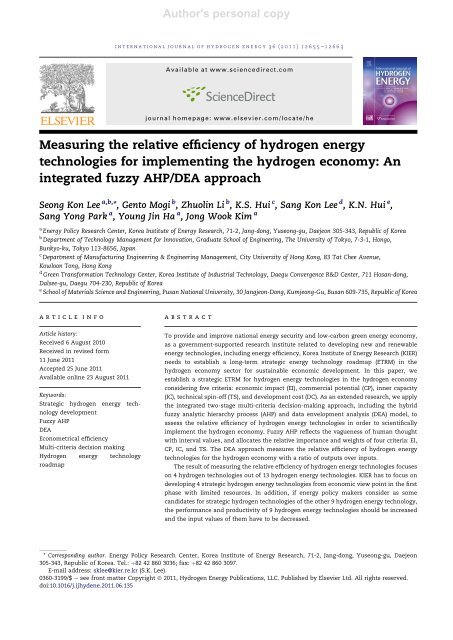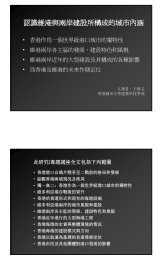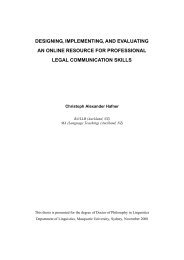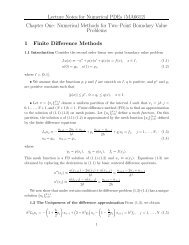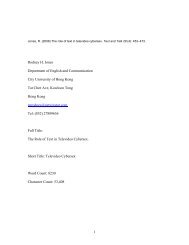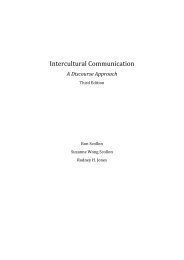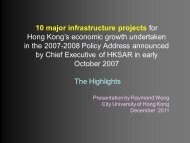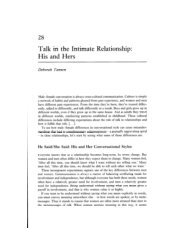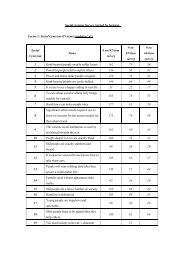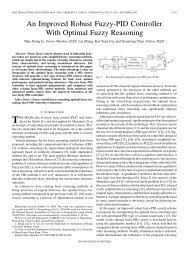Measuring the relative efficiency of hydrogen energy technologies ...
Measuring the relative efficiency of hydrogen energy technologies ...
Measuring the relative efficiency of hydrogen energy technologies ...
You also want an ePaper? Increase the reach of your titles
YUMPU automatically turns print PDFs into web optimized ePapers that Google loves.
Author's personal copyinternational journal <strong>of</strong> <strong>hydrogen</strong> <strong>energy</strong> 36 (2011) 12655e12663 12657Fig. 1 e Execution flowchart.natural language expression ra<strong>the</strong>r than crisp numbers inmaking assessments. The fuzzy set <strong>the</strong>ory deals with ambiguoussituations or situations that are not well defined. Thedata is presented to show human thoughts and perceptionsusing approximate information and uncertainty in order togenerate reasonable alternatives in decision-makingproblems.The concept <strong>of</strong> fuzzy <strong>the</strong>ory was introduced by Zadeh in1965 [7]. Fuzzy <strong>the</strong>ory includes fuzzy sets, membership functions,and fuzzy numbers to change vague data into usefuldata efficiently.Fuzzy set <strong>the</strong>ory implements groups <strong>of</strong> data with boundariesthat are not sharply defined. The merit <strong>of</strong> using <strong>the</strong>fuzzy approach is that it expresses <strong>the</strong> <strong>relative</strong> importance <strong>of</strong>alternatives and criteria with fuzzy numbers instead <strong>of</strong> crispnumbers because most decision making in <strong>the</strong> real worldtakes place in situations where pertinent data and <strong>the</strong>sequences <strong>of</strong> possible actions are not precisely known.Triangular and trapezoidal fuzzy numbers are generallyused to capture <strong>the</strong> vagueness <strong>of</strong> <strong>the</strong> parameters related toselect <strong>the</strong> alternatives. TFN is expressed with boundariesinstead <strong>of</strong> crisp numbers to reflect <strong>the</strong> fuzziness as decisionFig. 2 e Hierarchy <strong>of</strong> <strong>the</strong> fuzzy AHP.
Author's personal copyinternational journal <strong>of</strong> <strong>hydrogen</strong> <strong>energy</strong> 36 (2011) 12655e12663 12659W ¼ðdðA 1 Þ; dðA 2 Þ; .; dðA n ÞÞ T (11)where W is a non-fuzzy number.4.2. DEAThe DEA approach is a nonparametric MCDM assessment toolused in conjunction with decision-making units (DMUs) toeffectively solve many decision-making problems by simultaneouslyintegrating multiple inputs and outputs. Thisma<strong>the</strong>matical method has been used to solve a wide range <strong>of</strong>applications since 1978. The DEA is generally applied not onlyto assess <strong>the</strong> service productivity <strong>of</strong> banks [12], insurancecompanies [13], hospitals [14], universities [15] and restaurants,but also to evaluate <strong>the</strong> <strong>efficiency</strong> <strong>of</strong> R&D programs[16e18].Fig. 3 shows <strong>the</strong> hierarchy structure <strong>of</strong> <strong>the</strong> DEA process,which consists <strong>of</strong> a single input factor and multiple outputfactors. The input factor consists <strong>of</strong> <strong>the</strong> DC associated with <strong>the</strong>development <strong>of</strong> <strong>hydrogen</strong> economy <strong>technologies</strong>. The fouroutput factors are EI, CP, IC, and TS. The <strong>relative</strong> weightscalculated using <strong>the</strong> fuzzy AHP approach are applied inconjunction with <strong>the</strong> output factors employed as part <strong>of</strong> <strong>the</strong>DEA approach.The DEA ration form was first proposed by Charnes,Cooper, and Rhodes (CCR) [19], and was designed to measure<strong>the</strong> <strong>relative</strong> <strong>efficiency</strong> or productivity <strong>of</strong> a specific DMU k . TheDEA formulation is given as follows:Suppose <strong>the</strong>re is a set <strong>of</strong> n DMUs to be analyzed, each <strong>of</strong>which uses m common inputs and s common outputs.Let k (k ¼ 1,., n) denote <strong>the</strong> DMU whose <strong>relative</strong> <strong>efficiency</strong>or productivity is to be maximized, as represented byP sr¼1Max h k ¼u rkY rkP mi¼1 v (12)ikX ikP sr¼1s:tu rkY rkP mi¼1 v 1; for j ¼ 1; .; n (13)ikX iku rk > 0; for r ¼ 1; .; s (14)v ik > 0; for i ¼ 1; .; m (15)where u rk is <strong>the</strong> variable weight given to <strong>the</strong> rth output <strong>of</strong> <strong>the</strong>kth DMU, v ik is <strong>the</strong> variable weight given to <strong>the</strong> ith input <strong>of</strong> <strong>the</strong>kth DMU, u rk and v ik are decision variables determining <strong>the</strong><strong>relative</strong> <strong>efficiency</strong> <strong>of</strong> DMU k , Y rj is <strong>the</strong> rth output <strong>of</strong> <strong>the</strong> jth DMU,and X ij is <strong>the</strong> ith input <strong>of</strong> <strong>the</strong> jth DMU. This also assumes thatall Y rj and X ij are positive. The value h k is <strong>the</strong> <strong>efficiency</strong> score,which is less than and equal to 1. When <strong>the</strong> <strong>efficiency</strong> score <strong>of</strong>h k is 1, DMU k is regarded as an efficient frontier.The two types <strong>of</strong> CCR models are <strong>the</strong> input-oriented model,in which <strong>the</strong> inputs are maximized, and <strong>the</strong> output-orientedmodel, in which <strong>the</strong> outputs are maximized. Given that <strong>the</strong>focus is on maximizing multiple outputs, this paper used <strong>the</strong>following output-oriented CCR model:min px 0 (16)s:t qy 0 ¼ 1 (17)pX þ qY 0 (18)p 0; q 0; (19)where x 0 and y 0 are <strong>the</strong> input and output vectors <strong>of</strong> DMU o ,respectively. In Equation 18, X and Y variables refer tomatrices <strong>of</strong> inputs and outputs, respectively. Let an optimalsolution <strong>of</strong> LP 0 be (v*, u*). Then, an optimal solution <strong>of</strong> <strong>the</strong>output-oriented model is obtained fromp ¼ v =q ; q ¼ u =q : (20)Fig. 3 e Hierarchy <strong>of</strong> <strong>the</strong> DEA approach.
Author's personal copy12660international journal <strong>of</strong> <strong>hydrogen</strong> <strong>energy</strong> 36 (2011) 12655e12663Table 2 e Classification <strong>of</strong> <strong>hydrogen</strong> <strong>energy</strong> <strong>technologies</strong>.High-level Mid-level Low-Level Core <strong>technologies</strong>Technologies for <strong>the</strong><strong>hydrogen</strong> economyHydrogen Tech Hydrogen production Natural gas <strong>hydrogen</strong> production techThermochemical <strong>hydrogen</strong> production techWater electrolyzer <strong>hydrogen</strong> production techHydrogen separation& StorageChemical storage tech <strong>of</strong> solidHigh purity <strong>hydrogen</strong> production techFuel cell Tech PEMFC Portable fuel cell techFuel cell vehicle techHoem/Industry system techMicro fuel cellDMFCLaptop’s fuel cell techPortable fuel cell techSOFCFuel cell for power generationFuel cell for home & APUClearly, (p*, q*) is feasible for LP 0 . The optimal solutioncomes from Equation 21, presented asp x 0 ¼ v x 0 =q ¼ h (21)^x 0 ¼ x 0 t (22)In <strong>the</strong> first stage, we weigh <strong>the</strong> <strong>relative</strong> priority <strong>of</strong> low levels<strong>of</strong> <strong>hydrogen</strong> <strong>energy</strong> <strong>technologies</strong> using <strong>the</strong> fuzzy AHPapproach. We <strong>the</strong>n measure <strong>the</strong> <strong>relative</strong> <strong>efficiency</strong> <strong>of</strong> 13shortlisted <strong>hydrogen</strong> <strong>energy</strong> <strong>technologies</strong> on <strong>the</strong> second stageby using <strong>the</strong> DEA approach.^y 0 ¼ h y 0 þ t þ (23)where t * and t þ * are <strong>the</strong> slack variables <strong>of</strong> inputs and outputsrelated to DMU 0 , respectively.6. Numerical examples6.1. Priority <strong>of</strong> criteria5. Classification <strong>of</strong> <strong>hydrogen</strong> <strong>energy</strong><strong>technologies</strong> for <strong>the</strong> <strong>hydrogen</strong> economyHydrogen <strong>energy</strong> <strong>technologies</strong> are composed <strong>of</strong> five low levels<strong>of</strong> <strong>hydrogen</strong> <strong>energy</strong> <strong>technologies</strong> considered under Korea’s<strong>energy</strong> environment. The classified <strong>hydrogen</strong> <strong>energy</strong> <strong>technologies</strong><strong>of</strong> <strong>the</strong> <strong>hydrogen</strong> economy are shown in Table 2.We made pairwise comparisons <strong>of</strong> four criteria to assess <strong>the</strong><strong>hydrogen</strong> <strong>energy</strong> <strong>technologies</strong> in <strong>the</strong> sector <strong>of</strong> <strong>the</strong> <strong>hydrogen</strong>economy. Table 3 shows <strong>the</strong> fuzzy evaluation matrix withresponse to <strong>the</strong> goal.The result <strong>of</strong> <strong>the</strong> fuzzy evaluation <strong>of</strong> criteria, which is <strong>the</strong>mean value, is shown in Table 4.We calculated TFN values <strong>of</strong> <strong>the</strong> four criteria by using <strong>the</strong>fuzzy evaluation values in Table 4. The TFN values <strong>of</strong> <strong>the</strong>criteria are as follows:Table 3 e Fuzzy evaluation <strong>of</strong> <strong>the</strong> goal.EI CP IC TSEI (1, 1, 1) (1, 1, 1) (1, 1, 1) (2/3, 1, 3/2)(1, 1, 1) (2/3, 1, 3/2) (1, 1, 1) (2/3, 1, 3/2)(1, 1, 1) (1, 1, 1) (2/3, 1, 3/2) (3/2, 2, 5/2)- - - -- - - -CP (1, 1, 1) (1, 1, 1) (1, 1, 1) (2/3, 1, 3/2)(2/3, 1, 3/2) (1, 1, 1) (2/3, 1, 3/2) (1, 1, 1)(1, 1, 1) (1, 1, 1) (2/3, 1, 3/2) (3/2, 2, 5/2)- - - -- - - -IC (1, 1, 1) (1, 1, 1) (1, 1, 1) (2/3, 1, 3/2)(1, 1, 1) (2/3, 1, 3/2) (1, 1, 1) (2/3, 1, 3/2)(2/3, 1, 3/2) (2/3, 1, 3/2) (1, 1, 1) (2/3, 1, 3/2)- - - -- - - -TS (2/3, 1, 3/2) (2/3, 1, 3/2) (2/3, 1, 3/2) (1, 1, 1)(2/3, 1, 3/2) (1, 1, 1) (2/3, 1, 3/2) (1, 1, 1)(2/5, 1/2, 2/3) (2/5, 1/2, 2/3) (2/3, 1, 3/2) (1, 1, 1)- - - -- - - -- denotes that <strong>the</strong>re is ano<strong>the</strong>r value for ano<strong>the</strong>r expert’s fuzzyevaluation <strong>of</strong> criteria.S 1 ðEIÞ ¼ð3:97; 4:60; 5:40Þ5ð1=20:20; 1=16:60; 1=14:01Þ¼ ð3:97 1=20:2; 4:60 1=16:60; 5:40 1=14:01Þ¼ð0:20; 0:28; 0:39ÞS 2 ðCPÞ ¼ð3:97; 4:60; 5:40ÞÞ5ð1=20:20; 1=16:60; 1=14:01Þ¼ð0:20; 0:28; 0:39ÞS 3 ðICÞ ¼ð3:23; 3:80; 4:67ÞÞ5ð1=20:20; 1=16:60; 1=14:01Þ¼ð0:16; 0:23; 0:33ÞTable 4 e Fuzzy evaluation <strong>of</strong> criteria.EI CP IC TSEI (1.00, 1.00,1.00)CP (0.93, 1.00,1.10)IC (0.81, 0.90,1.03)TS (0.56, 0.80,1.17)(0.93, 1.00,1.10)(1.00, 1.00,1.00)(0.75, 0.90,1.13)(0.63, 0.80,1.07)(1.03, 1.20,1.40)(0.97, 1.20,1.50)(1.00, 1.00,1.00)(0.67, 1.00,1.50)(1.00, 1.40,1.90)(1.07, 1.40,1.80)(0.67, 1.00,1.50)(1.00, 1.00,1.00)
Author's personal copyinternational journal <strong>of</strong> <strong>hydrogen</strong> <strong>energy</strong> 36 (2011) 12655e12663 12661Table 5 e Values <strong>of</strong> V(S j ‡S i ).V(S 1 S i ) value V(S 2 S i ) valueTable 7 e 10-point scale for EI.ScaleDefinitionV(S 1 S 2 ) 1.00 V(S 2 S 1 ) 1.00V(S 1 S 3 ) 1.00 V(S 2 S 3 ) 1.00V(S 1 S 4 ) 1.00 V(S 2 S 4 ) 1.00V(S 3 S i ) value V(S 4 S i ) valueV(S 3 S 1 ) 0.72 V(S 4 S 1 ) 0.70V(S 3 S 2 ) 0.74 V(S 4 S 2 ) 0.70V(S 3 S 4 ) 1.00 V(S 4 S 3 ) 0.94S 4 ðTSÞ ¼ð2:85; 3:60; 4:73ÞÞ5ð1=20:20; 1=16:60; 1=14:01Þ¼ð0:14; 0:22; 0:34ÞWe compared <strong>the</strong> values <strong>of</strong> S i and calculated <strong>the</strong> degree <strong>of</strong>possibility <strong>of</strong> S j ¼ (l j , m j , u j ) S i ¼ (l i , m i , u i ) using Equation (8).Table 5 shows <strong>the</strong> values <strong>of</strong> V(S j S i ).We calculated <strong>the</strong> minimum degree possibility d 0 (i) <strong>of</strong>VðS j S i Þ for i,j ¼ 1,2,..,k.D 0 ð1Þ ¼min VðS 1 S 2 ; S 3 ; S 4 Þ¼min ð1:00; 1:00; 1:00Þ ¼1:00D 0 ð2Þ ¼min VðS 2 S 1 ; S 3 ; S 4 Þ¼min ð1:00; 1:00; 1:00Þ ¼1:00D 0 ð3Þ ¼min VðS 3 S 1 ; S 2 ; S 4 Þ¼min ð0:72; 0:74; 1:00Þ ¼0:72D 0 ð4Þ ¼min VðS 4 S 1 ; S 2 ; S 3 Þ¼min ð0:70; 0:70; 0:94Þ ¼0:70The weight vector is as follows:W 0 ¼ ð1:00; 1:00; 0:72; 0:70Þ TWe normalized <strong>the</strong> weight vectors as follows:W ¼ð0:29; 0:29; 0:21; 0:20Þ TThe final weights <strong>of</strong> EI, CP, IC, and TS, are 0.29, 0.29, 0.21, and0.20, respectively. Among <strong>the</strong> four criteria, EI and CP arepreferred over <strong>the</strong> o<strong>the</strong>r two.6.2. Quantitative data <strong>of</strong> shortlisted <strong>hydrogen</strong> <strong>energy</strong><strong>technologies</strong>Shortlisted <strong>hydrogen</strong> <strong>energy</strong> <strong>technologies</strong> to foster <strong>the</strong><strong>hydrogen</strong> economy are classified based on a 10-point scale.Table 6 shows <strong>the</strong> 10-point scale for IC and TS. The numbers 2,2 Potential <strong>energy</strong> saving is less than10,000 TOE/year,CO 2 emission reduction is less than10,000 tCO 2 /year4 Potential <strong>energy</strong> saving is between10,000 and 500,000 TOE/year,CO 2 emission reduction is between10,000 and 500,000 tCO 2 /year6 Potential <strong>energy</strong> saving is between500,000 and 1,000,000 TOE/year,CO 2 emission reduction is between500,000 and 1,000,000 Tco 2 /year8 Potential <strong>energy</strong> saving is between1,000,000 and 2,000,000 TOE/year,CO 2 emission reduction is between1,000,000 and 5,000,000 tCO 2 /year10 Potential <strong>energy</strong> savings is greater than2,000,000 TOE/year,CO 2 emission reduction is greater than5,000,000 tCO 2 /year1, 3, 5, 7, 9 Intermediate values are used tocompromise between two judgments4, 6, 8, and 10, which correspond to <strong>the</strong> extent <strong>of</strong> preference forone element over o<strong>the</strong>rs, are used as scaling ratios. Forexample, a technology with a score <strong>of</strong> 10 can be regarded asexhibiting a degree <strong>of</strong> IC and TS much higher than that <strong>of</strong> <strong>the</strong>o<strong>the</strong>r <strong>technologies</strong>. Conversely, a score <strong>of</strong> 2 means that one<strong>energy</strong> technology ranks much lower than <strong>the</strong> o<strong>the</strong>rs in terms<strong>of</strong> a particular criterion.Tables 7 and 8 display <strong>the</strong> 10-point scale for <strong>the</strong> EI and <strong>the</strong> CP,respectively. A score <strong>of</strong> 10 for EI implies potential <strong>energy</strong> savings<strong>of</strong> more than 2 million TOE/year, or a reduction in CO 2 emissionsgreater than 5 million tCO 2 /year. Meanwhile, a score <strong>of</strong> 10for <strong>the</strong> possibility <strong>of</strong> commercialization indicates that a particular<strong>energy</strong> technology is currently at <strong>the</strong> technology disseminationphase, and that core patents and <strong>the</strong> dissemination <strong>of</strong><strong>the</strong> <strong>energy</strong> technology can be secured within three years.Table 9 shows a single input and multiple outputs data, whichare shortlisted <strong>energy</strong> <strong>technologies</strong> in <strong>the</strong> sector <strong>of</strong> <strong>the</strong> <strong>hydrogen</strong>economy. It describes <strong>the</strong> data multiplied by <strong>the</strong> fuzzy AHPresults for measuring <strong>the</strong> <strong>relative</strong> <strong>efficiency</strong> <strong>of</strong> <strong>energy</strong> <strong>technologies</strong>in <strong>the</strong> <strong>hydrogen</strong> economy using <strong>the</strong> DEA approach.Table 6 e 10-point scale for IC and TS.ScaleDefinition2 Inner capacity and technical spin-<strong>of</strong>f areat an extremely low level4 Inner capacity and technical spin-<strong>of</strong>f areat a low level6 Inner capacity and technical spin-<strong>of</strong>f areat a medium level8 Inner capacity and technical spin-<strong>of</strong>f areat a high level10 Inner capacity and technical spin-<strong>of</strong>f areat an extremely high level1, 3, 5, 7, 9 Intermediate values are used tocompromise between two judgmentsTable 8 e 10-point scale for CP.ScaleDefinition2 Phase <strong>of</strong> quickening technology development, needarises to research new technological concepts4 Phase <strong>of</strong> technology development, component<strong>technologies</strong> need to be developed6 Core patent acquirement phase8 Commercialization phase, core patents can beobtained and <strong>technologies</strong> commercializedwithin 3e5 years10 Technological dissemination phase, core patentscan be acquired and <strong>technologies</strong> disseminatedwithin 3 years1, 3, 5, 7, 9 Intermediate values are used to compromisebetween two judgments
Author's personal copy12662international journal <strong>of</strong> <strong>hydrogen</strong> <strong>energy</strong> 36 (2011) 12655e12663Table 9 e Single input and multi outputs data <strong>of</strong> shortlisted <strong>hydrogen</strong> <strong>energy</strong> <strong>technologies</strong>.Low-level Shortlisted <strong>energy</strong> tech Inputs OutputsDevelopment cost(mil.KRW) EI CP IC TCHydrogen Production tech Hydrogen production tech from natural gas 500 8.0 7.0 9.0 8.0Thermalchemical <strong>hydrogen</strong> production tech 500 7.0 4.0 7.0 7.0Water electrolysis <strong>hydrogen</strong> production tech 500 6.0 5.0 6.0 7.0Hydrogen separation & storage tech Chemical storage tech <strong>of</strong> solid 500 7.0 5.0 7.0 7.0High purity <strong>hydrogen</strong> separation tech 500 7.0 4.0 7.0 7.0PEMFC tech Portable fuel cell tech 540 8.0 8.0 9.0 8.0Fuel cell vehicle tech 540 8.0 8.0 9.0 9.0Home/Industry system tech 500 8.0 7.0 8.0 8.0DEFC tech Micro fuel cell tech 500 6.0 6.0 8.0 7.0Laptop’s fuel cell tech 500 6.0 7.0 8.0 7.0Portable power fuel cell tech 500 6.0 7.0 8.0 7.0SOFC tech Power generation fuel cell tech 540 6.0 7.0 4.0 4.0Home/APU fuel cell tech 540 6.0 7.0 4.0 4.0Table 10 e Preferred data applied to <strong>the</strong> fuzzy AHP results.Low-level Shortlisted <strong>energy</strong> tech Inputs OutputsDevelopment cost(mil.KRW) EI CP IC TSHydrogen Production tech Hydrogen production tech from natural gas 500 2.32 2.04 1.90 1.64Thermalchemical <strong>hydrogen</strong> production tech 500 2.04 1.17 1.48 1.44Water electrolysis <strong>hydrogen</strong> production tech 500 1.75 1.46 1.27 1.44Hydrogen separation& storage techChemical storage tech <strong>of</strong> solid 500 2.04 1.46 1.48 1.44High purity <strong>hydrogen</strong> separation tech 500 2.03 1.17 1.48 1.44PEMFC tech Portable fuel cell tech 540 2.34 2.34 1.90 1.64Fuel cell vehicle tech 540 2.34 2.34 1.90 1.85Home/Industry system tech 500 2.34 2.04 1.69 1.64DEFC tech Micro fuel cell tech 500 1.75 1.75 1.69 1.44Laptop’s fuel cell tech 500 1.75 2.04 1.69 1.44Portable power fuel cell tech 500 1.75 2.04 1.69 1.44SOFC tech Power generation fuel cell tech 540 1.75 2.04 0.84 0.82Home/APU fuel cell tech 540 1.75 2.04 0.84 0.82Table 10 shows <strong>the</strong> preferred data applied to <strong>the</strong> fuzzy AHPcriteria’ <strong>relative</strong> weights, wherein four multiple inputs dataare changed.6.3. Relative <strong>efficiency</strong> <strong>of</strong> <strong>hydrogen</strong> <strong>energy</strong> <strong>technologies</strong>We calculated <strong>the</strong> <strong>relative</strong> <strong>efficiency</strong> <strong>of</strong> <strong>hydrogen</strong> <strong>energy</strong><strong>technologies</strong> by using <strong>the</strong> DEA approach in <strong>the</strong> second stage.Table 11 shows <strong>the</strong> <strong>relative</strong> <strong>efficiency</strong> scores and <strong>the</strong> ranks <strong>of</strong><strong>hydrogen</strong> <strong>energy</strong> <strong>technologies</strong>.An <strong>efficiency</strong> score <strong>of</strong> 1.000 means an <strong>energy</strong> technologyhas been determined to belong to <strong>the</strong> efficient frontier groupusing <strong>the</strong> DEA model. In addition, an <strong>efficiency</strong> score <strong>of</strong> 1.000is <strong>the</strong> optimal status considering <strong>the</strong> ratio <strong>of</strong> output variablesover input variables from benefit cost analysis concept. If an<strong>efficiency</strong> score <strong>of</strong> portable fuel cell technology <strong>of</strong> PEMFC isTable 11 e Relative <strong>efficiency</strong> scores and ranks.Low-level Shortlisted <strong>energy</strong> tech Efficiency score RankHydrogen Production Tech Hydrogen production tech from natural gas 1.000 1Thermalchemical <strong>hydrogen</strong> production tech 0.875 8Water electrolysis <strong>hydrogen</strong> production tech 0.840 13Hydrogen separation & storage tech Chemical storage tech <strong>of</strong> solid 0.875 8High purity <strong>hydrogen</strong> separation tech 0.875 8PEMFC tech Portable fuel cell tech 1.000 1Fuel cell vehicle tech 1.000 1Home/Industry system tech 1.000 1DEFC tech Micro fuel cell tech 0.889 7Laptop’s fuel cell tech 0.951 5Portable power fuel cell tech 0.951 5SOFC tech Power generation fuel cell tech 0.875 8Home/APU fuel cell tech 0.875 8
Author's personal copyinternational journal <strong>of</strong> <strong>hydrogen</strong> <strong>energy</strong> 36 (2011) 12655e12663 126631.000, <strong>the</strong>re is no need for addition increase <strong>of</strong> output performanceand input increase. If an <strong>efficiency</strong> score <strong>of</strong> micro fuelcell technology <strong>of</strong> DEFC is 0.889, in that case, <strong>the</strong>re is needed toconsider <strong>the</strong> quantity increase <strong>of</strong> outputs and <strong>the</strong> quantitydecrease <strong>of</strong> inputs for having <strong>the</strong> <strong>efficiency</strong> score 1.000 as anefficient frontier group.The efficient frontier group, consisting <strong>of</strong> <strong>hydrogen</strong> <strong>energy</strong><strong>technologies</strong>, includes four <strong>technologies</strong> achieving <strong>relative</strong><strong>efficiency</strong> scores <strong>of</strong> 1.000: <strong>hydrogen</strong> production technologyfrom natural gas, portable fuel cell technology, fuel cellvehicle technology, and home/industry system. The o<strong>the</strong>rnine <strong>hydrogen</strong> <strong>energy</strong> <strong>technologies</strong> have been found to be<strong>relative</strong>ly inefficient DMUs, following a comparison with <strong>the</strong><strong>relative</strong> <strong>efficiency</strong> scores.7. ConclusionsIn this research, have expounded on how <strong>hydrogen</strong> <strong>energy</strong><strong>technologies</strong> measure <strong>relative</strong> <strong>efficiency</strong> using <strong>the</strong> DEAapproach based on performance and productivity. In <strong>the</strong> firststage, we allocated <strong>the</strong> <strong>relative</strong> weights <strong>of</strong> low levels <strong>of</strong><strong>hydrogen</strong> <strong>energy</strong> <strong>technologies</strong> using <strong>the</strong> fuzzy AHP approach.In <strong>the</strong> second stage, we measured <strong>the</strong> <strong>efficiency</strong> scores using<strong>the</strong> DEA approach. Fuzzy AHP effectively reflects humanthoughts with vagueness <strong>of</strong> real world decision-makingproblems compared with AHP, which only evaluates <strong>the</strong><strong>relative</strong> weights with crisp numbers.4 <strong>hydrogen</strong> <strong>energy</strong> <strong>technologies</strong>, <strong>hydrogen</strong> productiontechnology from natural gas in <strong>the</strong> sector <strong>of</strong> <strong>hydrogen</strong>production and portable fuel cell technology, fuel cell vehicletechnology, home/industry system technology in <strong>the</strong> sector <strong>of</strong>PEMC, are <strong>the</strong> most efficient <strong>technologies</strong> that should befocused on strategically with a view point <strong>of</strong> productivity andperformance. The o<strong>the</strong>r 9 <strong>hydrogen</strong> technology have to beadjusted <strong>the</strong> quantity values <strong>of</strong> input and output variables forbeing <strong>the</strong> <strong>efficiency</strong> frontier group.The results <strong>of</strong> this research can provide <strong>energy</strong> policymakers with optimal alternatives for resource allocation andfor implementing well-focused R&D as <strong>the</strong>y establish andevaluate <strong>the</strong> priority and <strong>efficiency</strong> <strong>of</strong> <strong>hydrogen</strong> <strong>energy</strong> <strong>technologies</strong>in <strong>the</strong> <strong>hydrogen</strong> economy sector. We plan to carry outfur<strong>the</strong>r studies using <strong>the</strong> hybrid fuzzy AHP/DEA scale <strong>efficiency</strong>approach and slack-based measurement [20].AcknowledgmentThis work was supported by <strong>the</strong> KIER Basic Fund and by <strong>the</strong>HERC. The author would also like to express his gratitude to <strong>the</strong>experts who participated in establishing <strong>the</strong> <strong>hydrogen</strong> ETRM.NomenclatureAHPCPDEADEFCDMUAnalytic hierarchy processCommercial potentialData envelopment analysisDirect ethanol fuel cellDecision-making unitEIETRMICMCDMPEMFCSOFCTSEconomic impactEnergy technology roadmapInner capacityMulti-criteria decision-makingPolymer electrolyte membrane fuel cellSolid oxide fuel cellTechnical spin-<strong>of</strong>freferences[1] Year book <strong>of</strong> <strong>energy</strong> statistics 2010. Ministry <strong>of</strong> KnowledgeEconomy; 2010.[2] KEPCO in brief 2009. Korea Electric Power Corporation; 2009.[3] Lee WY. Activities <strong>of</strong> <strong>hydrogen</strong> fuel cells in Korea. In:Proceeding <strong>of</strong> 3rd fuel cells and <strong>hydrogen</strong>; 2010.[4] Lee SK, Kim JW. World <strong>energy</strong> outlook and measures. KIER-A52417; 2005:299e354.[5] Lee SK, Mogi G, Kim JW. Energy technology roadmap for <strong>the</strong>next 10 years: <strong>the</strong> case <strong>of</strong> Korea. Energy Policy 2009;37:588e96.[6] Lee SK, Mogi G, Lee SK, Kim JW. Prioritizing <strong>the</strong> weights <strong>of</strong><strong>hydrogen</strong> <strong>energy</strong> <strong>technologies</strong> in <strong>the</strong> sector <strong>of</strong> <strong>the</strong> <strong>hydrogen</strong>economy by using a fuzzy AHP approach. InternationalJournal <strong>of</strong> Hydrogen Energy 2011;36:1897e902.[7] Zadeh LA. Fuzzy sets. Information and Control 1965;8:338e53.[8] Saaty TL. The analytic hierarchy process. 1st ed. New York:McGraw-Hill; 1980.[9] Lee SK, Yoon YJ, Kim JW. A study on making a long-termimprovement in <strong>the</strong> national <strong>energy</strong> <strong>efficiency</strong> and GHG controlplans by <strong>the</strong> AHP approach. Energy Policy 2007;35:2862e8.[10] Lee SK, Mogi G, Kim JW. The competitiveness <strong>of</strong> Korea asa developer <strong>of</strong> <strong>hydrogen</strong> <strong>energy</strong> technology: <strong>the</strong> AHPapproach. Energy Policy 2008;36:1284e91.[11] Chang DY. Applications <strong>of</strong> <strong>the</strong> extent analysis method on fuzzyAHP. European Journal <strong>of</strong> Operational Research 1996;95:649e55.[12] Schaffnit C, Rosen D, Paradi JC. Best practice analysis <strong>of</strong> bankbranches: an application <strong>of</strong> DEA in a large canadian bank.European Journal <strong>of</strong> Operations Research 1997;98:269e89.[13] Mahajan J. A data envelopment analytic model for assessing<strong>the</strong> <strong>relative</strong> <strong>efficiency</strong> <strong>of</strong> <strong>the</strong> selling function. EuropeanJournal <strong>of</strong> Operational Research 1991;53:189e205.[14] Chang HH. Determinants <strong>of</strong> hospital <strong>efficiency</strong>: <strong>the</strong> case <strong>of</strong>central government-owned hospitals in Taiwan. Omega1998;26:307e17.[15] Casu B, Thanassoulis E. Evaluating cost <strong>efficiency</strong> in centraladministrative services in UK universities. Omega 2006;34:417e26.[16] Vitner G, Rozenes S, Spraggett S. Using data envelope analysisto compare project <strong>efficiency</strong> in a multi-project environment.International Journal <strong>of</strong> Project Management 2006;24:323e9.[17] Lee SK, Mogi G, Kim JW. Multi-Criteria decision making formeasuring <strong>relative</strong> <strong>efficiency</strong> <strong>of</strong> greenhouse gas<strong>technologies</strong>: aHP/DEA hybrid model approach. EngineeringLetters 2008;16:493e7.[18] Lee SK, Mogi G, Lee SK, Hui KS, Kim JW. Econometric analysis<strong>of</strong> <strong>the</strong> R&D performance in <strong>the</strong> national <strong>hydrogen</strong> <strong>energy</strong>technology development for measuring <strong>relative</strong> <strong>efficiency</strong>:<strong>the</strong> fuzzy AHP/DEA integrated model approach. InternationalJournal <strong>of</strong> Hydrogen Energy 2010;35:2236e46.[19] Charnes A, Cooper WW, Rhodes E. <strong>Measuring</strong> <strong>the</strong> <strong>efficiency</strong><strong>of</strong> decision making units. European Journal <strong>of</strong> OperationsResearch 1978;2:429e44.[20] Lee SK, Mogi G, Koike M, Hui KS, Kim JW. A fuzzy AHP/DEAscale <strong>efficiency</strong> approach for prioritizing <strong>energy</strong> <strong>technologies</strong>econometrically, paper for <strong>the</strong> CORS-INFORMS TorontoInternational; 2009. Toronto, 14e17.


